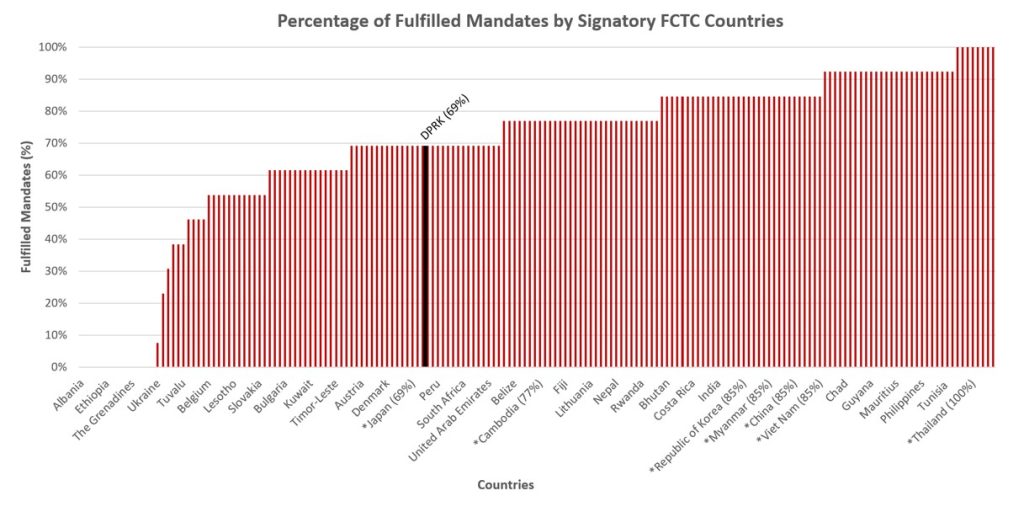North Korea’s Participation in Multilateral Health Agreements: The Case of WHO’s Framework Convention on Tobacco Control
 Since joining the United Nations (UN) in 1991, the Democratic People’s Republic of Korea (DPRK), also known as North Korea, has joined the international community to promote various health-related initiatives. For many of these initiatives, North Korea works with the World Health Organization (WHO). In this article, we describe how North Korea has followed through with the mandates of the Framework Convention on Tobacco Control (FCTC) and explore its implications for future participation in multilateral health agreements and the potential for cooperation in the health sector with external partners.
Since joining the United Nations (UN) in 1991, the Democratic People’s Republic of Korea (DPRK), also known as North Korea, has joined the international community to promote various health-related initiatives. For many of these initiatives, North Korea works with the World Health Organization (WHO). In this article, we describe how North Korea has followed through with the mandates of the Framework Convention on Tobacco Control (FCTC) and explore its implications for future participation in multilateral health agreements and the potential for cooperation in the health sector with external partners.
What is the FCTC?
The WHO’s Framework Convention on Tobacco Control was first introduced in 2003. The goal of this convention was to reduce the global prevalence of tobacco use through an evidence-based approach. The signatory countries are required to submit reports on a biannual basis. These reports include data on the prevalence of tobacco use and also contain information about the country’s progress in implementing domestic tobacco control policies. As one of the 168 signatory countries of the WHO FCTC, North Korea has reported data in 2012, 2014, 2018 and 2020.
What Are the Mandates for the Member States Who Signed Onto the Convention?
Article 5 of the FCTC includes the General Obligations of the Convention. These obligations involve implementing tobacco control strategies, establishing a tobacco control unit, reducing interference by the tobacco industry, providing public access to information on tobacco companies and instilling protections for public health policies. On the FCTC’s website, reports are available for each obligation. Our analysis shows that North Korea has fulfilled 69 percent of its FCTC mandates. That places North Korea right at the global average for the percentage of mandates fulfilled by all the signatory countries. Other countries at the same level of compliance include Japan, Denmark, Austria, Peru and South Africa. North Korea has outperformed in compliance when compared to countries like Belgium, Kuwait, Ukraine and Slovakia. In contrast, countries like Fiji, Nepal, India, China and the Philippines have fulfilled more of their obligations when compared to North Korea.

Since 2018, North Korea has integrated tobacco control into its national health strategies and has established a tobacco control unit (with a focal point and a national coordinating mechanism). In its 2020 report, the country provided details about how it will protect public health policies, regarding tobacco control, and also documented progress made in these efforts. According to this report:
The Cabinet leads tobacco control with cooperation with relevant stakeholders including Korea Tobacco Association, which is tobacco control agency for the control of production, sale, import and export of tobacco products in line with National policy. Tobacco Cessation centre conducts tobacco control programs including tobacco counselling, tobacco cessation, IEC and research on tobacco control.
Despite this progress, North Korea has not met some specific benchmarks. For example, it has incorporated tobacco control into national health strategies, but it has not yet created a comprehensive multi-sectoral approach. In addition, it has not stopped interference by the tobacco industry or provided public access to information about the tobacco industry. Lastly, Pyongyang has not provided details on the use of implementation guidelines; however, 80 percent of the signatory countries did not fulfill this mandate either.
It is important to note that North Korea’s tobacco industry is a state enterprise; therefore, the government has an inherent conflict between the profits made from tobacco and the detrimental public health effects of smoking. Other Southeast Asian countries, such as China, Vietnam, Laos and Thailand, also face this dilemma. In 2019, the Southeast Asia Tobacco Control Alliance published a report highlighting how state-owned tobacco enterprises complicate the implementation of FCTC mandates. In this report, Thailand was commended for its efforts to protect health policies from the influences of its tobacco industry. Its success stemmed from a combination of a committed Ministry of Public Health, which provided vital leadership on policy and law, a dedicated civil society and the effective utilization of mass media (SEATCA, 2019).
What Has North Korea Done to Reduce Public Tobacco Use?
In 1985, North Korea introduced its first policy to reduce the prevalence of smoking within its borders. This policy later became the basis for the country’s first law regulating nationwide tobacco use—the Tobacco Control Law in 2005. Over the years, they have strengthened this law through multiple amendments. In November 2020, North Korea also adopted a new anti-smoking law at the Supreme People’s Assembly. Although the details of the law have not been fully disclosed, it contains more stringent regulations such as listing smoking-free public areas along with stronger enforcement, compared to the previous Tobacco Control Law.
In addition to the aforementioned legislation, North Korea has also addressed tobacco use through public health interventions as well. According to North Korean websites:
- North Korea has hosted international meetings on the World No Tobacco Day (May 31st) every year from 2016 to 2019 to discuss tobacco control; these discussions include various public health interventions at local and nationwide levels. However, due to the COVID-19 pandemic, this meeting was not held in 2020 or 2021.
- There is also a central smoking cessation center in Pyongyang, which provides the public with education about tobacco cessation and offers multiple smoking cessation products, such as cessation tablets, gum and eundan (an herbal smoking cessation pill).
- One video on a North Korean website showed the development of a domestic nicotine patch. North Korea has limited opportunities for international collaboration on developing smoking cessation products, such as nicotine patches—an unintended consequence of the strict sanctions imposed on them. The leader of the research team was later awarded the first prize in the national science and technology contest. Although little is known about the safety and efficacy of the product, nonetheless, the video showed North Korea’s ingenuity and commitment toward tobacco control.
How Has the Implementation of the FCTC Reduced Tobacco Smoking in North Korea?
In 2020, the self-reported prevalence of tobacco use among North Korean men was 46.1 percent. In addition, the prevalence of daily smoking among men was 38.4 percent. Murray et al. (2017) reported that the age-adjusted prevalence of daily smoking among North Korean men in 2015 was 36.7 percent, while the global average was 25 percent. This indicates that smoking rates in North Korea are still comparatively high.
It is worth noting that the Institute for Health Metrics and Evaluation (IHME) data map showed a relatively higher prevalence of daily smoking among males in most of Eastern Asia, Central Asia, Southeastern Asia and Eastern European regions. In some cultures, smoking is still a well-accepted means of socializing. There are even instances where tobacco products are used as currency or gifted as an expression of gratitude. To better understand the high prevalence of tobacco use among males in North Korea, it may be necessary to study the social, cultural and economic contexts in the country.
Furthermore, the prevalence of smoking in adolescent males, from 13 to 15 years of age, was 1.3 percent in 2020. An interesting observation we wanted to highlight is that all the smokers in North Korea were males; there were zero female smokers reported. This difference in smoking prevalence may be secondary to cultural factors, or they may reflect gender inequalities within the society. Regardless, the lower (and non-existent) smoking rates among adolescents and females, respectively, can still be chalked up as a positive public health outcome, as the harmful effects of smoking are more pronounced in children and women (Bonnie et al., 2015).
Other Examples of North Korea Following Through With Health-Related Multilateral Agreements
A common misperception is that North Korea is unwilling to collaborate with the international community. However, the country has demonstrated a willingness to sign onto agreements when it comes to protecting the health of its people. As we mentioned earlier, the 2020 FCTC report showed that the smoking prevalence among men (aged 15 years and older) has decreased since implementation of the FCTC began, yet the prevalence remains relatively high. Despite the modest results, the self-assessment and international reporting, as well as compliance with the bulk of the mandates of the FCTC, have demonstrated a high level of commitment and follow-through. This is not an isolated case. In addition to the FCTC, North Korea regularly participates in other health-related initiatives, at least within the WHO and the UN system. Some examples are listed below:
- In June 2021, the North Korean government released the “Voluntary National Review on the Implementation of the 2030 Agenda for Sustainable Development.” We should not be surprised that its report for Goal #3, “Ensure healthy lives and promote well-being for all,” contains statistics that they are proud of, such as the reduction in maternal mortality and neonatal mortality. But, notably, the report also acknowledges challenges such as the shortage of essential medications and low technical foundation for pharmaceutical manufacturing.
- World Health Assembly Resolution 68.15 from 2015 called for “strengthening emergency and essential surgical care and anaesthesia as a component of universal health coverage.” The US was a co-sponsor of this resolution, and North Korea, as a member of the Executive Board of the WHO at the time, was one of the strongest supporters. Pursuant to the resolution, North Korea included the provision of emergency and essential surgical care at district hospitals as a target in its Medium Term Strategic Plan for the Development of the Health Sector 2016-2020.
- North Korea signed the United Nations Convention on the Rights of Persons with Disabilities in 2013 and ratified it in 2016. The Convention came into effect in January 2017. North Korea submitted the initial report to the Convention in 2018 to explain how the policies are implemented to protect rights of persons with disabilities in the state. They also invited Catalina Devandas Aguilar, the United Nations Special Rapporteur on the Rights of Persons with Disabilities, to visit the country in 2017 (OHCHR, 2017).
Conclusion
North Korea generally follows through with its responsibilities when signing on to multilateral health agreements such as the WHO FCTC, World Health Assembly resolutions, and Sustainable Development Goals. As a signatory to the WHO FCTC, North Korea has regularly submitted its reports and has implemented various domestic policies to reduce tobacco use. In fact, its percentage of fulfilled FCTC mandates (69 percent) was in line with the average compliance of all signatory countries. As the international community seeks to engage with North Korea in the health sector, aligning with the aims of these international health agreements may help find areas of shared interests and cooperation.
References:
- Asian State-Owned Tobacco Enterprises: Challenges & Opportunities in Implementing WHO FCTC Article 5.3. Bangkok: Southeast Asia Tobacco Control Alliance, SEATCA, 2019. https://seatca.org/dmdocuments/AsianStateOwnedTobaccoEnterprises_Report_web.pdf.
- The Committee on the Public Health Implications of Raising the Minimum Age for Purchasing Tobacco Products; Board on Population Health and Public Health Practice; Institute of Medicine. Public Health Implications of Raising the Minimum Age of Legal Access to Tobacco Products. Edited by Richard J. Bonnie, Kathleen Stratton, and Leslie Y. Kwan. Washington, DC: National Academies Press, 2015.
- “UN disability expert welcomes opportunity for constructive dialogue on human rights in North Korea.” OHCHR, May 15, 2017. https://www.ohchr.org/EN/NewsEvents/Pages/DisplayNews.aspx?NewsID=21615
- Murray, Christopher JL, Forouzanfar, Mohammad H., Gakidou, Emmanuela, et al. “Smoking prevalence and attributable disease burden in 195 countries and territories, 1990–2015: a systematic analysis from the Global Burden of Disease Study 2015.” The Lancet 389, no. 10082 (2017): 1885-1906, https://doi.org/10.1016/S0140-6736(17)30819-X.
